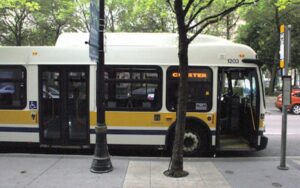
In a number of cases councillors have asked builders to create new plans that preserve trees. Pictured: Hamilton Mayor Andrea Horwath. Photo Credit: City of Hamilton.
With Hamilton Councillors backing an ambitious city-wide Urban Forest Strategy earlier in their term, council is taking a strict approach when it comes to developers who are planning to cut down trees in order to build.
Whereas some development plans have proposed cutting down mature trees in order to make room for housing, in a number of cases councillors have asked builders to create new plans that preserve trees.
Council previously endorsed a plan for the city to plant 20,000 trees each year with the goal of growing Hamilton’s tree canopy cover from 21.2 per cent to 40 per cent by 2050.
With the plan, councillors committed the city to undertake 26 actions, including creating new staffing positions, implementing an urban forest communications strategy, and undertaking complete land cover and canopy cover mapping.
Among those 26 actions are multiple measures targeted towards developers.
The strategy instructs staff to “ensure that required landscape and tree protection plans submitted as part of development applications are fully implemented.”
The strategy also calls for staff to “develop and apply minimum canopy cover targets to new development proposals.”
Staff are also looking at various pieces of legislation, policies, plans, standards and guidelines that can be used to advance the city’s tree canopy cover goal.
Those amendments include potential changes to planning processes, various guidelines, or zoning by-laws that can be made or altered “to improve urban forest canopy retention and establishment.”
There have been a number of notable cases so far where developers have been asked to come up with new plans in order to save trees.
For example, a development plan for Southcote Road proposed removing 10 trees in order to build three homes, but the builder was told to revise the plan.
In that case a new plan was drawn up that will see all the trees on the property preserved and the homes built.
According to the city’s tree canopy data, Glanbrook, Upper Stoney Creek, and Hamilton Mountain have some of the lowest tree cover percentages.
Ward 8, which encompasses the West Mountain and Central Mountain, has the lowest percentage, with only 7.6 per cent tree canopy coverage.
Meanwhile, Ward 13, which is made up of the community of Dundas, has the highest tree coverage in the city at 40.3 per cent.
But overall, the city of Hamilton’s 21 per cent tree canopy coverage is lower than Guelph (28.6 per cent), Oakville (27.8 per cent), Cambridge (27 per cent), and even Toronto (26.6 per cent).
It is important to note that large swaths of land in Hamilton have historically been cleared of trees for industrial purposes while other areas have been previously cleared for agricultural reasons.
City staff assert that Hamilton’s urban forest “provides $8.2 million in ecosystem services” every year including reducing runoff and lowering energy costs and therefore a strict approach is warranted.

Based in Hamilton, he reaches hundreds of thousands of people monthly on Facebook, Instagram, TikTok, and Twitter. He has been published in The Hamilton Spectator, Stoney Creek News, and Bay Observer. He has also been a segment host with Cable 14 Hamilton. In 2017, he received the Chancellor Full Tuition Scholarship from the University of Ottawa (BA, 2022). He has also received the Governor General’s Academic Medal. He formerly worked in a non-partisan role on Parliament Hill in Ottawa.


















